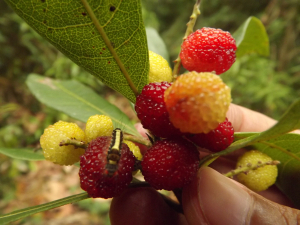Matu Hamru, Paani Hamru,
Hamra hi chhan yi baun bhi!
Ours is the earth, Ours is the water
Ours is the fields, forest and fodder!
———song composed during Chipko movement.
Sudesha (right) in her courtyard with a friend, 2013
I spent the summer of 2014 with one of the first Chipko movement activists, Sudesha Devi. We were in her village home at Rampur, tucked away within the Hemal river valley of Tehri Garhwal, Uttarakhand. Sudesha lives there with her son, daughter-in-law and two grandchildren.Though the whole family was overwhelmingly hospitable to me, it was Sudesha with whom I spent most of my time. I followed her around through all her daily tasks—going with her to the field, on long walks to graze the cows, and just sitting by the fire while cooking daal in the evenings. During all this, Sudesha told me stories about her role in the early Chipko movement and how it grew and impacted so many young women’s lives; she also sang several songs from the movement which revealed the essence of the struggle and her belief in self sustenance that inspired Chipko. This was primarily a forest conservation movement which went on to become a landmark for future environmental protests across the world and was heralded as the first eco-feminist people’s movement. Chipko initially spread through several villages in the Garhwal hills of Uttarakhand as people collectively hugged trees to drive away fellers; it then spread as a forest conservation drive through Rajasthan, Haryana, Karnataka and other states. The movement grew from forest conservation alone to standing for the preservation of indigenous varieties of plants and agricultural techniques. It also saw the rise of women as the leaders of this drive, seeking their own rights as equal participants in administrative bodies in villages.
Sudesha as a young woman before the Chipko movement, with her husband and daughter, in the 1970s
Spending the valuable time over summer with Sudesha meant that she showed me how she very practically continues to follow the philosophy she preaches—growing her own grain, millets and vegetables through holistic farming techniques and depending largely on seasonal wild fruits. Here is a little more from my learning experience with this extremely wise and witty old lady.
When Sudesha was a young girl living in her father’s house near Chamba, the Gandhian activist Sarla Behen visited her village. She went around giving public lectures on self-sustenance and the ill effects of alcohol. Sarla Behen became a very inspiring figure for Sudesha, both for what she said and for being a female political leader who was always away from her home, travelling constantly. When the need rose for a women’s struggle against the felling of trees by contractors in the forests adjoining her village in Rampur (the village she was married into), Sudesha did not have to think twice. She took to the forests by night along with other young women like herself and stayed amongst the trees, improvising songs and sharing bits of food to keep their collective strength from ebbing before the fear of armed men employed by the mighty contractors. From one local victory to the next, theirs was a war of a kind. Sudesha recalls feeling quite afraid at first as they had nothing to support them except their own motivation to protect the forest that gave them their basic food, fuel and fodder.
This lack of support meant that Chipko was also an act of defiance against their own families for Sudesha and her colleagues; they had to go against the will of the authorities within home—mother-in-law, husband etc. Sudesha also expressly pointed out to me, during one of our many conversations, that this assertion of freedom against oppressive family structures was central to Chipko, for soon after the movement started, women in the villages began to speak out against the alcoholism rampant across the region. These struggles were an integrated struggle for Sudesha and others—they took on company contractors, their own families and the local administration, in a fight which gave them a new voice as women with rights and as leaders of a people’s movement that spread like wildfire.
While staying with Sudesha, a large part of the day was spent grazing the cows in the field and chasing them off neighbour’s crops. However, in the late afternoons when the cows were well fed and back in the house courtyard, Sudesha and I would go down to her field where a rich variety of daal (pulses), koda, kaddu (pumpkin), bhindi (okra) and other vegetables would greet us.
Bhindi plants growing with complete natural fertilizer and organic seeds at Sudesha's farm, Rampur
Her style of farming, as learnt from her father, is baranaja or 12 mixed cropping. Though this practice does not literally mean that every rotation of sowing must have only 12 crops, it refers to the twin sustainability principles of maintaining a balance in soil nutrition and of making the most of crop production by using that which is not edible as fodder. This has been carried out over generations in Garhwal, and the various combinations of plants to be sowed at one time in order to maintain soil fertility have been mastered over the ages. Practicing baranaja, Sudesha’s field has soil which is so rich that it needs no chemical fertilizer whatsoever, and often even very little water! All the seeds for Sudesha’s farming are carefully preserved from one year to the next and some over generations, in meticulously kept glass bottles (ironically, bottles for alcohol left behind by her late husband).
Organic seeds of Rajma, Jhingora, Bhindi, Kaddu, Kakdi, being preserved over the years in old alcohol bottles at Sudesha's home
Amongst the crops she shows me, both in her field and as preserved as seeds, are Koda/Mandwa (finger millet), Marsa/Ramdana (amaranth), Gahath (kulath daal), Bhatt (black soyabean), Urad daal, Bhanjgir (hemp seeds), Til (sesame), Ogal (kuttu) and a wide variety of colourful rajma. She said that when she was younger there was a custom of exchanging seeds between villages and even across valleys, but now she trusted very few farmers to use completely organic and indigenous varieties, and therefore wouldn’t take the risk of ruining her precious land! At her field, crops tangle into each other and I would watch as Sudesha wove her way between them, handling each plant with a friendly touch and almost whispering to them in a strange language of their own. She said that the earth in her field was so fertile that she did not need to water it at all, and that seeds she had planted even four years earlier would suddenly sprout forth to yield a few more surprise vegetables or pods of daal. Though this life might seem completely attached to basic sustenance, it is ripe with a deep understanding of what Sudesha recalls as being at the heart of Gandhi’s Swadeshi; it is also the essence of what has now come to be called eco-feminism, that began in these valleys with Chipko.
What was in addition completely new to me was the number of wild fruits that Sudesha could spot and collect for her family during the summer months. Most of these were berries, some of which had stories and songs attached to them which I found being sung across the region. Walking anywhere with Sudesha was therefore a picnic of sorts, as we continuously munched on Bedu (a small sour black berry), Timla (fig), Hinsar (tiny pink edible flowers) or Kaafal (the king of the wild fruits—a sweet and sour red berry).

Kaafal, the king of wild berries in Uttarakhand
But when we would go down to the village market, Sudesha would despair at the fast urbanizing village. I recall her saying that education was only helping turn young minds away from the fact that everyone however great, even the gods, have to eat the same grain and so we better learn to grow it! Over the years, though the Chipko movement has been influential at the policy level for marking off ‘protected forest’ cover in Uttarakhand, deforestation is rampant, as is the unchecked damming of rivers that is causing large scale soil erosion across valleys. The opposition to the construction of dams in this region was very strong during the building of the Tehri Dam over the Tehri river, Garhwal, from 1978 onwards, and Sudesha along with other women who had previously been leaders of Chipko were vocal in this movement. Sudesha recalls animatedly how she and her colleagues went head on against local police and were jailed for a period of three weeks during the Tehri dam protest. Over the years, with the nexus between governments, builders and corporations growing only stronger in the anti-ecological and unsustainable developmental modes, Sudesha and other environmentalists have created channels of sustainability that still spell hope. Today she is part of the Beej Bachao Andolan (Save the Seeds Movement) which distributes indigenous varieties of seeds across the country through a network of people from Garhwal to Delhi. This has brought in a new interest from ecologically conscious individuals within urban areas as well, who wish to gain a deeper understanding of indigenous plants and sustainability. More inspiring than anything however, is the fact that Sudesha’s own life continues to flower in exactly the same philosophy it has been rooted in over decades of change around her.












